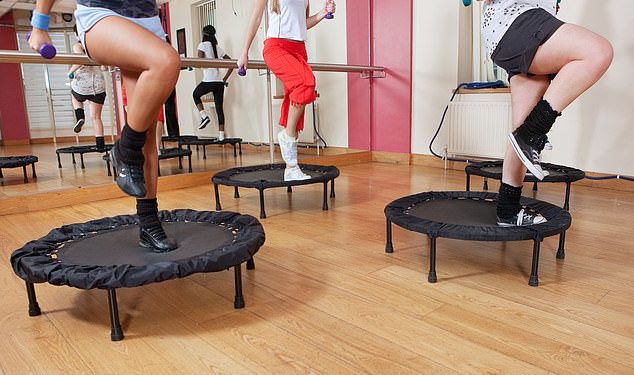Daily Mail journalists select and organize the products that appear on our site. If you make a purchase via links on this page, we will win a commission – learn more
A little -known NASA backup technique could be the secret for effortlessness weight loss.
Ten minutes of “rebound” – bouncing on a Mini trampoline – is almost 70% more efficient for weight loss than a 30 -minute jog, according to a Nasa Study in 1980 which recently resurfaced online.
Exercise requires people to jump higher and engage more muscles than typical training, resulting in greater calorie burns and fat loss.
And it’s not just about losing book.
Dr. Michael Aziz, attending physician at Lenox Hill in New York, told Daily Mail: “The rebound or the jump on a mini trampoline offers many health benefits, including better heart health, an increase in metabolism and an improved function of the lymphatic system”.
Exercise strengthens the heart muscle, resulting in a drop in blood pressure and a heart rate at rest, improves blood circulation and oxygen administration throughout the body, while stimulating the way it eliminates toxins and potentially harmful waste.
The rebound also strengthens endurance, which facilitates the execution of other exercises and daily activities – and, over time, increases metabolism.

The “rebound” is a form of exercise that involves jumping and bouncing on the mini trampoline to improve overall health
Mini trampolines are widely available from popular retailers for as little as $ 50.
In the original NASA study, the researchers asked eight participants aged 19 to 26 to walk and run on a four -speed treadmill and jump on a trampoline with four variable heights.
During each activity, scientists measured the absorption of oxygen, acceleration levels and heart rate.
They found that with similar levels of heart rate and oxygen absorption, jumping On a trampoline has led to more calories and complete movement of the body than to run.

Dr. Michael Aziz is a doctor at Lenox Hill Hospital in New York
Dr. Aziz estimated that 15 minutes of rebound can burn about 150 calories.
On the other hand, a 15 -minute walk at a moderate pace usually burns around 60 to 100 calories.
While browsing five miles per hour for 15 minutes, burns 120 calories for a person weighing 125 pounds.
To lose a fat book in a week, a person must create a calorie deficit of 3,500 over seven days – 500 calories less per day – either by a diet, or by a diet or exercise.
To achieve this, someone could bounce back for about 50 minutes a day, against two hours of walking or an hour of racing.
Dr. Aziz said: “It’s great for those who need cardio but without the exhaustion of the treadmill. It also has a low impact, so it is easier on joints than cycling and jogging.
Training sessions often involve jogging on site, making jumps, divided jumps, taps and cracks from hand to knees – high intensity movements burn calories.
For those looking to start the rebound, Dr. Aziz advises to start slowly and develop. “If you go stronger, the rebound can be a form of high intensity training training.
“High intensity or HIIT interval training has the most impact on longevity and can add nine years to your life.
“It is years beyond aerobic and anaerobic exercise. Saping on a mini trampoline can also help balance and coordination skills.

For optimal weight loss results, experts recommend people to bounce back for at least 20 to 30 minutes, three to five times a week
He said the rebound was also good for those who suffered from joint pain and the elderly suffering from arthritis.
Although the race is mainly a training of the lower body, the rebound distributes the force through the whole body, reducing the joint strain.
This week, a study revealed that children aged 35 to 50 who regularly run marathons are more likely to develop precancerous tumors in their colonprecursors of the disease.
Out of the 100 patients studied by DC scientists, 41% proved to have at least one adenoma – a benign tumor that can turn into cancer.
Fifteen percent had advanced adenomas, or more advanced growth with more than half of the rectal bleeding, a sign of potential warning.
Dr. Timothy Cannon, the medical oncologist who led research, told Daily Mail that the results were higher than the doctors would expect in the general population and justified a more in -depth investigation.
Dr. Cannon said that all distance runners suffering from colon cancer signs, such as rectal bleeding, should be tested for illness, whatever their age.
The study was observational, it is therefore not clear if the distance distance increases the risk or if other lifestyle factors, such as food, play a role.




